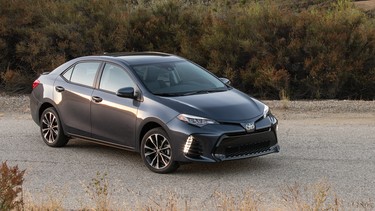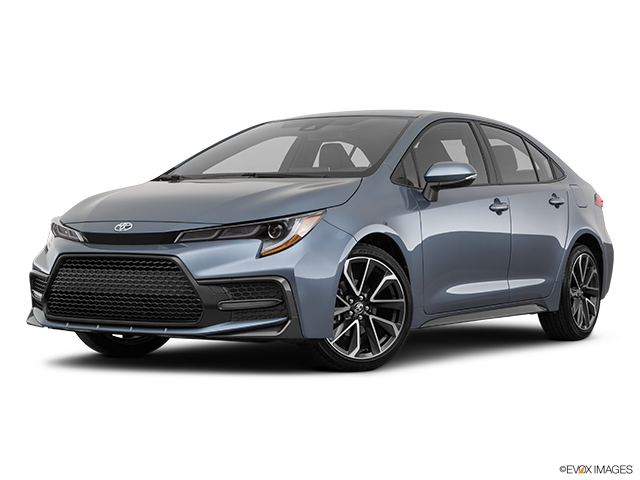5 tips to find a first-class example of a second-hand Toyota Corolla.

Article content
The 11th-generation Toyota Corolla Sedan first hit the road in 2013 for the 2014 model year and ran through model-year 2019.
Advertisement 2
Article content
This top-selling, Canadian-built favourite is a major player in the compact segment and has been a best-seller for Toyota, thanks in no small part to a strong reputation for reliability and a fuss-free ownership experience. The Corolla is one of the first used cars that comes to mind when a friend or reader asks for a recommendation on something easy to drive, easy on fuel, and easy on maintenance.
Few cars on the road have earned such a stellar reputation for reliability, though the actual condition of the used Corolla you’re considering will depend more on how it’s been treated and cared for by previous owners as the years and miles start to add up.
This generation of Toyota Corolla is well known for fuel economy, a quality interior, generous standard advanced safety features, a smooth ride on most surfaces, and an above-average predicted reliability rating. Some owners wish for more pleasing acceleration and handling, and a more exciting overall drive.
Advertisement 3
Article content
Under the hood, look for a 1.8-litre four-cylinder engine with the driver’s choice of automatic or six-speed manual transmission, depending on the model and grade selected. All units were front-wheel drive.
-
![First Look: 2017 Toyota Corolla]()
First Look: 2017 Toyota Corolla
-
![Car Review: 2018 Toyota Corolla]()
Car Review: 2018 Toyota Corolla
Note that the Corolla was available in hatchback configurations through different parts of this generation, but this guide focuses on the Corolla Sedan.
Key competitors include the Honda Civic, Kia Forte, Subaru Impreza, Mazda3, Ford Focus, and Chevrolet Cruze.
Follow the links above for additional features, news, reviews and specifications on the Toyota Corolla and competitors, and read on for five tips to help make sure you find the best used model possible for your dollar.
Advertisement 4
Article content
Model-year changes

This generation Corolla sedan spanned six model years, with numerous updates and changes taking place during that time.
Importantly, model-year 2017 brought new standard feature content including bi-LED headlamps on CE and LE trims, multi-LED lighting standard on SE and XSE grades, a standard 6.1-inch infotainment interface, and a redesigned and upgraded cockpit with enhancements to comfort and convenience. A more aggressive grille treatment capped off the front end.
Toyota also added its pre-collision system with pedestrian detection, dynamic radar cruise control, lane departure alert with steering assist, and automatic high beams to the standard equipment list for all trim grades in a major move forward, and the interior also received updates with a new instrument panel and trim designs.
Advertisement 5
Article content
The 2017 Toyota Corolla was offered in six models with a choice of six-speed manual transmission or continuously variable transmission with intelligent shift (CVTi-S). Each model had its own set of standard equipment and available upgrade packages, including the Corolla SE with automatic climate control, a 4.2-inch cluster display, multi-LED headlamps, and more. An available upgrade package added 17” alloy wheels, rear disc brakes, and a power tilt/slide moon roof.
The Corolla LE ECO model featured a special 1.8-litre four-cylinder engine (140 hp) with variable valve technology to boost performance and fuel efficiency. It also came standard with a 3.5” information display and a windshield wiper de-icer system.
Advertisement 6
Article content
For 2018, the Corolla became available in a fully-loaded XLE trim grade with available six-speed manual.
- Seek a 2017+ model for maximum safety equipment.
- Seek a 2018+ XLE for a fully loaded experience.
- Corolla CE is the entry trim grade.
- Corolla Eco models offered improved efficiency.
Toyota Corolla transmission trouble

According to discussion forums within the Corolla owners’ community, some owners have reported trouble with the CVT transmission available in this generation of Corolla, especially in earlier years; the vast majority have not.
For context, the number of owners reporting transmission trouble is a small fraction of overall owners. Still, test-driving shoppers should take some steps to ensure the CVT transmission in the Corolla they are considering is healthy and trouble free.
Advertisement 7
Article content
Start by exposing the transmission to a variety of operating conditions on your test drive. Perform a 10-point turn, carefully shifting from drive to reverse multiple times in quick succession and being careful to stop the vehicle fully before switching gears. Note the time it takes to shift, and that delays or clunking are signs of trouble.
Be sure to try accelerating slowly, moderately, and at full throttle too.
Watch for unusually high engine revs, whining or grinding sounds, shuddering, vibrations, or a major delay when a throttle input is applied. If you notice any of these warning signs on your test drive, proceed with caution and have a technician investigate before you buy.
Though the Corolla’s CVT transmission is a ‘filled for life’ unit stated not to require any fluid change under normal conditions, many owners choose to change their transmission fluid every 50,000 or 60,000 kilometres, just to be safe. If you choose this precaution, this work should be done only in a dealer setting.
Advertisement 8
Article content
- Most owners do not report trouble.
- Watch for signs of slipping, grinding, lagging or delay.
- Clunking or unwanted high revs are trouble signs.
- Consider transmission fluid changes.
Toyota Corolla recalls

Recall work is performed free of charge by dealerships to address latent safety defects.
In this generation Corolla, recalls include fuel pumps which could fail and cut power while you’re driving, improperly built torque converters on model-year-2019 units, and improperly manufactured block-heater cords that could pose a fire risk.
Transport Canada lists eight recalls for this generation of Toyota Corolla sedan, and you can check to see which (if any) apply to the used Corolla you’re considering by entering its VIN here.
Advertisement 9
Article content
- Recalls affect some vehicles and not others.
- Use Toyota’s online recall lookup.
- Dealers perform recall work free of charge.
Battery headaches
Some owners have reported batteries that drip, leak, or split as they age; most have not.
A leaky battery can hurt you, damage your car, and prevent the engine from starting. On your test drive, locate the Corolla’s battery and check its condition. The electrical connectors bolted to the battery should be clean and free of gunk or a salty-looking crust. Check carefully on and around the battery for signs of an acid leak, which can corrode and damage nearby parts and wiring.
Remember to clean your Corolla’s battery terminals regularly and trickle charge it if you’ll be parked for more than a week to help condition the battery and prevent surprise battery drain.
Advertisement 10
Article content
Remember not to attempt replacing or disconnecting your Corolla’s battery yourself, as you could cause serious headaches with other vehicle systems. If the battery in your Corolla needs servicing, seek professional assistance.
- Leaky batteries can cause several problems.
- Clean terminals and trickle-charge regularly.
- Battery should only be serviced by a professional.
Toyota Corolla paint issues

While Blue Crush seems to be the Corolla paint colour most affected by this issue, this tip is a good check for any used Corolla you might be considering, regardless of colour. It also marks the first time in hundreds of used car guides that we’re adding a tip specifically for a certain colour of car: the ‘Blue Crush’ Corolla.
Advertisement 11
Article content
Based on various owner forum discussions (such as here and here), test-driving shoppers are advised to carefully inspect the condition of the vehicle’s paint job. Shoppers should pay close attention to the hood edge and the edges of the every door, as well as the trunk. Numerous owners have reported paint that easily chips from corners and edges over time.
Note that the vehicle’s previous owner may have had this issue dealt with already, but that damage to a vehicle’s paint (or poorly repaired damage) can invite rust, diminish resale value, and cause other problems.
- Check for peeling and chipping paint around panel edges.
- ‘Blue Crush’ paint is a prime suspect.
- Damaged paint can cause rust and other problems.
Final thought
These tips are designed to help test-driving shoppers more easily identify problems reported by some owners. A careful and attentive test drive that focuses on the areas above can help you find a first-class example of a second-hand Toyota Corolla.
Stay connected with us on social media platform for instant update click here to join our Twitter, & Facebook
We are now on Telegram. Click here to join our channel (@TechiUpdate) and stay updated with the latest Technology headlines.
For all the latest Automobiles News Click Here





Comments
Postmedia is committed to maintaining a lively but civil forum for discussion and encourage all readers to share their views on our articles. Comments may take up to an hour for moderation before appearing on the site. We ask you to keep your comments relevant and respectful. We have enabled email notifications—you will now receive an email if you receive a reply to your comment, there is an update to a comment thread you follow or if a user you follow comments. Visit our Community Guidelines for more information and details on how to adjust your email settings.
Join the Conversation